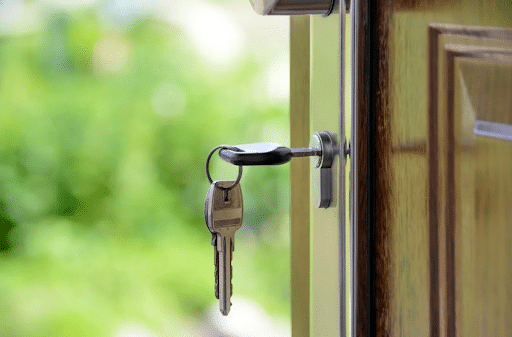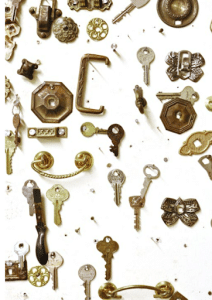Introduction
Have you ever found yourself locked out because of a lost or broken key? Key cutting is the solution to your problem. This process involves creating a duplicate key based on an existing one. Understanding how it works can be quite beneficial, especially in emergencies.
The key duplication process varies depending on the type of key. Factors such as time, location, and cost can also influence the process. Some keys may have duplication restrictions, which require authorization from a locksmith or the originating center.
In this article, we will explore the intricate world of key cutting. We will discuss the various types of keys, their respective cutting methods, and factors to consider when you need a duplicate key. We will also delve into the roles of licensed locksmiths in ensuring the accuracy and security of your duplicate keys.

Understanding Key Cutting
To fully grasp the process of key cutting, it’s essential to delve into its mechanics. At its core, key cutting is the art of carving a piece of metal (the blank key) to match the unique pattern of an existing key. This intricate procedure ensures that the newly-cut key will fit and turn within the same lock.
The key cutting process usually involves two main steps:
- Tracing: The original key’s pattern is traced onto the blank key, marking where the cuts need to be made.
- Cutting: The marked areas are then cut using specialized machines, following the traced pattern with precision.
In this process, locksmiths play a pivotal role. They not only provide the technical expertise needed for accurate cutting but also ensure that all necessary security measures are followed. The professional handling of keys by licensed locksmiths helps in maintaining confidentiality and reduces chances of unauthorized duplication.
Locksmith services extend beyond simply cutting keys. They advise on suitable key types, handle complicated cuts for high-security keys, and offer solutions for lost or broken keys. Their understanding of different lock systems and keys can be invaluable when you find yourself locked out or in need of a duplicate key.

https://www.pexels.com/photo/black-handled-key-on-key-hole-101808/
Peeling back the layers of this process reveals an intriguing blend of art and science. As we venture further into specifics, remember: Knowledge empowers you to make informed decisions when it comes to securing your home or business.
Types of Keys and Their Key Cutting Methods
Not all keys are the same. Different keys have different characteristics that affect how they are cut. Knowing the type of key you have is the first step towards making a duplicate. In this section, we will discuss some common types of keys: small Yale keys, mortice keys, Chubb keys, and safe keys.
1. Small Yale Keys
Small Yale keys are the standard keys used for houses. They are usually flat with notches or cuts on one side. These keys are popular in residential properties because they are simple and affordable.
The cutting process for small Yale keys involves using a specific machine to copy the unique cut pattern from your original key onto the blank one. This machine has a rotating wheel that makes precise cuts on the blank key while following the pattern of the original key.
This process requires careful attention to detail and accuracy because even a small mistake can make the duplicate key unusable.
Sometimes, locksmiths may use special tools or techniques if your small Yale key has extra security features like side milling or dimples. These additional features need more specialized equipment to accurately replicate them on your duplicate key.
2. Mortice/Chubb Keys
Mortice keys or Chubb keys are commonly found in older properties. They have a distinct look with a long stem and several rectangular bits cut into one end.
Because of their intricate design, mortice/Chubb keys need a more precise cutting method compared to small Yale keys. The process usually involves a skilled locksmith manually filing each bit on the blank mortice key to match the original.
Accuracy is crucial when cutting these types of keys because the bits must align perfectly to work with the levers inside a mortice lock. Even a slight deviation can prevent the key from functioning.
3. Safe Keys
Safe keys have unique features that make them harder to duplicate than regular keys. They are often double-sided or have dimples, which interact with pins inside the lock in a specific way to open the safe.
Cutting safe keys requires specialized knowledge and equipment because of their complexity. It’s not just about copying a pattern; it involves understanding how the key works with the lock mechanism.
A professional locksmith would use a specialized machine made for cutting these types of keys, considering each unique characteristic like depth, spacing, and angle of cuts or dimples.
Each type of key has its own complexities that affect how it is duplicated. Whether you have small Yale keys, mortice/Chubb keys, or safe keys, knowing their distinct characteristics and cutting methods can increase the chances of a successful duplication process.
2. Mortice/Chubb Keys
Introduction to Mortice/Chubb Keys
A significant player in the realm of home security systems is the mortice key, also known as Chubb key. Named after its inventor, Charles Chubb, this type of key boasts a unique and intricate design, setting it apart from standard keys like small Yale keys.
Mortice/Chubb keys are typically associated with heavy-duty locks such as deadbolt locks or sash locks commonly found in residential and commercial properties. They feature a thick metal shaft with notches cut into the edge. The noticeable characteristic of these keys is their level of detail and precision, which makes them more secure but also more challenging to duplicate accurately.
Key Cutting Process for Mortice/Chubb Keys
Creating a duplicate for a mortice/Chubb key requires a keen eye for detail due to the complex design involved. It’s essential to ensure that every notch and groove aligns perfectly with the original, or else the duplicate may fail to operate the lock.
The process starts with selecting a blank key that matches the original in size and design. Using a professional-grade key cutting machine, the locksmith will then carefully trace the pattern of notches from the original onto the blank. It’s a meticulous process where even minor errors can render the duplicate useless.
Takeaway: Given their intricate designs, mortice/Chubb keys underscore the importance of accuracy during duplication. Even minute discrepancies can result in ineffective duplicates, emphasizing why such tasks should be entrusted to skilled professionals.
3. Safe Keys
Safe keys are often used for securing valuables within a home or business setting. These keys have a distinct design characterized by a series of cuts and notches on both sides of the key blade. This intricate design increases the security level of the lock as it becomes more difficult to pick or manipulate.
Key Cutting Process for Safe Keys
The cutting process of safe keys demands specialized knowledge and equipment due to their complex structure. Here are the key steps involved:
- Identifying the Key Blank: The first step involves identifying the correct key blank that matches the original safe key. This is critical as using an incorrect blank can render the duplicate key useless.
- Cutting the Key: After identifying the correct blank, it’s time to cut the duplicate key. The locksmith will place the original and blank keys side by side on a key cutting machine and trace the pattern of cuts from the original onto the blank.
- Refining and Testing: Post cutting, refining is necessary to remove any sharp edges or burrs that may interfere with smooth insertion into the lock. Once refined, it’s essential to test this newly cut key in a lock to ensure it functions correctly.
It’s worth noting that safe keys require a higher degree of precision during cutting due to their double-sided design and multiple depth levels of cuts. So, an experienced locksmith with specialized equipment is typically best suited for this task.
As we delve deeper into various types of keys, it becomes evident that each comes with its own set of complexities and requirements for duplication – whether they are small Yale keys, mortice/Chubb keys or safe keys.
Key Factors to Consider When You Need a Duplicate
When you require a duplicate key Blanks, there are several critical factors to consider. These include understanding key restrictions, the importance of using a licensed locksmith, and dealing with specific dealer restrictions on key duplication.
1. Key Restrictions and Authorization Requirements
Restricted Keys
Restricted keys are unique in that they offer an extra layer of security over standard keys. These keys are not easily duplicated due to their specialized design, which is often patented, making unauthorized duplication illegal. Examples of restricted keys include ‘Do Not Copy’ or ‘Do Not Duplicate’ keys.
Why Restricted Keys Require Special Handling
These keys present a challenge during the duplication process due to their complex designs and legal implications. They often require special equipment and skilled locksmiths for accurate duplication. Additionally, these keys typically require authorization from the owner or original issuing center before they can be duplicated.
Levels of Key Control
There are various levels of key control, each with its own set of rules and restrictions:
- Basic: This level consists of standard keys that can be easily duplicated by most locksmiths without needing any special authorization.
- Medium: This category includes semi-restricted keys that may require some form of verification before duplication.
- High: High-level key control involves restricted or high-security keys, which demand explicit authorization and specialized locksmith services for duplication.
Understanding these varying levels will help you anticipate what to expect when you need a duplicate key and how to navigate any potential challenges.
Importance of Using a Licensed Locksmith
When you need a duplicate key, especially for those with restricted keys or do not copy engravings, choosing a licensed locksmith is more than just a smart choice—it’s a necessity. Restricted keys often have specific dealer restrictions and may require authorized duplication to maintain their integrity and security.
Expertise and Credibility
A licensed locksmith brings a wealth of expertise and credibility to the key duplication process. These professionals are not only skilled in cutting various key types but also understand the legalities involved with restricted and protected key designs. The Master Locksmiths Association (MLA) stands out as a notable industry organization, endorsing vetted and qualified locksmiths who adhere to high standards of workmanship and ethical practice.
Key takeaway: To ensure a smooth key duplication experience, always be aware of any restrictions on your key type and seek assistance from licensed professionals or authorized dealers when necessary.
Verifying Credentials
To verify the credentials of a locksmith, consider the following tips:
- Check for MLA Approval: Confirm that the locksmith is approved by the MLA. This approval indicates that they have undergone rigorous checks and qualifications.
- Seek Recommendations: Ask for recommendations from friends or family who have had positive experiences with qualified locksmiths.
- Look for Identification: A trustworthy locksmith will readily provide identification and evidence of their qualifications upon request.
- Read Reviews: Online reviews can offer insights into the reliability and service quality of a locksmith.
Remember that using an unlicensed individual for key duplication can result in poorly crafted keys that may fail to work or even damage your lock. In some cases, it could also void warranties, such as with Ultion keys, which often require cutting by specific dealers to maintain their validity.
By entrusting your needs to a licensed professional, you not only ensure that your duplicate key operates flawlessly but also uphold any stipulations set forth by your key’s manufacturer or designer. This peace of mind is invaluable, particularly when dealing with high-security locks and keys that protect your most valuable assets.
3. Dealing with Specific Dealer Restrictions for Key Duplication
When it comes to obtaining a duplicate key, one challenge that you might encounter is dealing with specific dealer restrictions. Some manufacturers or dealers implement key control policies to maintain the security and integrity of their products. A common example is Ultion keys, which are often subject to such restrictions.
Ultion keys are renowned for their high-security features. The manufacturers have put in place stringent measures to prevent unauthorized duplication. Consequently, these keys can only be duplicated by specific dealers authorized by Ultion. This measure seeks to ensure the keys’ superior security levels aren’t compromised through unauthorized duplication.
Understanding these restrictions is crucial when you need a duplicate key. It’s not merely about walking into any locksmith shop and getting a copy. You must be aware of the nuances associated with your particular key type and follow the recommended process for duplication.
So, what options do you have when dealing with restricted keys like Ultion? Here are a couple of possibilities:
- Contacting the Original Seller: Your first point of contact should be the dealer who originally sold you the key or lock system. They are likely an authorized dealer who can either provide you with a duplicate or guide you through the process.
- Providing Proof of Ownership: In some cases, presenting proof of ownership may be necessary to get a duplicate key. This could include documentation like receipts or warranty papers that show you are the legitimate owner of the lock system.
Bear in mind that not all locksmiths will be able to help with restricted keys due to these control policies. Therefore, it’s pivotal to seek assistance from licensed professionals or authorized dealers who adhere to these standards.
This approach ensures your safety and guarantees that your key’s security is not undermined during the duplication process. So before rushing off to get your duplicate, remember: understanding the nature of your key and any associated restrictions can make the process much smoother and more secure.
Understanding Key Cutting Time and Cost Considerations
When you need a duplicate key, it’s important to know what factors affect how long it takes and how much it costs to cut a key. The main things that influence both of these are the complexity of the key design and the type of machine that’s used.
Factors Influencing Key Cutting Time:
- Complexity of Key Design: Keys that have intricate patterns and high-security features take more time to make sure they’re copied correctly.
- Type of Cutting Machine: Manual machines might take longer than automated ones, but they can also be more precise.
- Experience of the Locksmith: Skilled locksmiths are able to work faster and make fewer mistakes, which can help speed up the process.
Factors Influencing Cost of Key Cutting:
- Key Blank Material: The type of material used for the key blank can affect the cost. Durable materials like brass or steel are usually more expensive than basic metals.
- Security Features: Keys that have advanced security features, such as transponder chips, will cost more because they require special technology to copy.
- Urgency of Service: If you need the key cut right away, there may be an extra charge for expedited service.
While it’s good to find a service that can quickly cut your key, you should also make sure that the quality is not being compromised. Poorly made duplicates can damage your lock or cause it to fail, which could end up costing you even more money to replace in the future. Sometimes, it’s worth paying a bit more for a well-made key that you know will work perfectly.
Accuracy is crucial when it comes to duplicating keys; a badly cut key could mean the difference between being able to get into your property or being locked out. So when you’re choosing a key cutting service, keep this in mind and make your decision carefully.
DIY Key Cutting: Pros and Cons
DIY key cutting has become more accessible with the advent of automated machines available in hardware stores and even some large retailers. Here’s a closer look:

Advantages
- Convenience: These machines are often located in easily accessible places, allowing you to create a duplicate key within minutes.
- Cost Savings: Typically cheaper than going to a professional locksmith, DIY key cutting can be a budget-friendly option for standard key types.
Limitations
- Accuracy Issues: Automated machines might not provide the precision that professional locksmith equipment offers, which can result in poorly functioning keys.
- Restricted Key Types: Not all keys can be copied using DIY methods; high-security or specialized keys often require professional equipment and expertise.
Recommendations
- Suitable Situations: For basic house keys without special features, DIY key cutting machines can be effective and economical.
- Professional Assistance: If you have a high-security key, such as those for advanced locking systems or vehicles, it’s advised to seek services from a licensed locksmith to ensure the integrity of the key is maintained.
The choice between DIY key cutting and professional services depends on various factors including the type of key you need duplicated and your personal requirements for accuracy and security. As you weigh these options, remember that the security of your property is paramount. Moving forward, consider these insights when deciding on how best to duplicate your keys.
Conclusion
Having a duplicate key is crucial. Whether it’s for avoiding lockouts or simply having an extra set, the value of a spare key cannot be ignored.
Now that you understand how key cutting works, you realize the importance of factors like key restrictions and authorization requirements. You also understand why using a licensed locksmith can make a big difference in the quality and security of your duplicate keys.
As you deal with your key duplication needs, keep in mind any specific restrictions that may be imposed by dealers. Don’t hesitate to seek guidance from professional locksmiths or the original seller in such cases.
While DIY methods may seem convenient and cost-effective, they often fail to provide accurate and secure duplicates, especially for complex keys. So, despite the potential expenses and time involved, prioritize accuracy and security when getting keys replicated.
With these insights, you’re now ready to handle the key duplication process smoothly and securely. Be vigilant, stay informed, and most importantly, have a reliable set of duplicate keys!
Equip yourself with the knowledge needed to navigate the key-cutting process.
Remember: Your safety is worth more than saving a few minutes or dollars.
FAQs (Frequently Asked Questions)
What will be covered in the section about understanding key cutting?
In this section, we will provide an in-depth explanation of key cutting and how it works. We will also highlight the role of locksmiths in the key cutting process and why it's often recommended to seek professional help.
How are small Yale keys typically used?
Small Yale keys are commonly used as residential key types.
What unique considerations are there for cutting safe keys?
Safe keys have unique features that make them more complex to cut than standard keys. The key cutting process for safe keys emphasizes the need for specialized knowledge and equipment.
Why do restricted keys require special handling during the duplication process?
Restricted keys require special handling during duplication due to various levels of key control, from basic restrictions to authorized duplication requirements.
Why is it important to use a licensed locksmith for key duplication?
Using a licensed locksmith ensures expertise and credibility in providing key duplication services. The Master Locksmiths Association (MLA) is highlighted as a reputable industry organization, and tips for verifying locksmith credentials are provided.
What factors can influence the time and cost of key cutting?
Factors such as accuracy, quality, and specific key types can influence the time required to cut a key accurately, as well as the associated costs for this service.
What are the pros and cons of DIY key cutting?
DIY key cutting through automated machines offers convenience and cost savings but may have limitations such as accuracy issues and restrictions on certain key types. Recommendations for suitable situations for DIY methods versus professional assistance are provided.
How should readers apply the information in this guide for future key duplication processes?
Readers are urged to apply the key factors discussed in this guide to ensure a smooth and secure key duplication process in the future. The significance of having a spare key for emergencies and everyday convenience is emphasized as a final thought.


